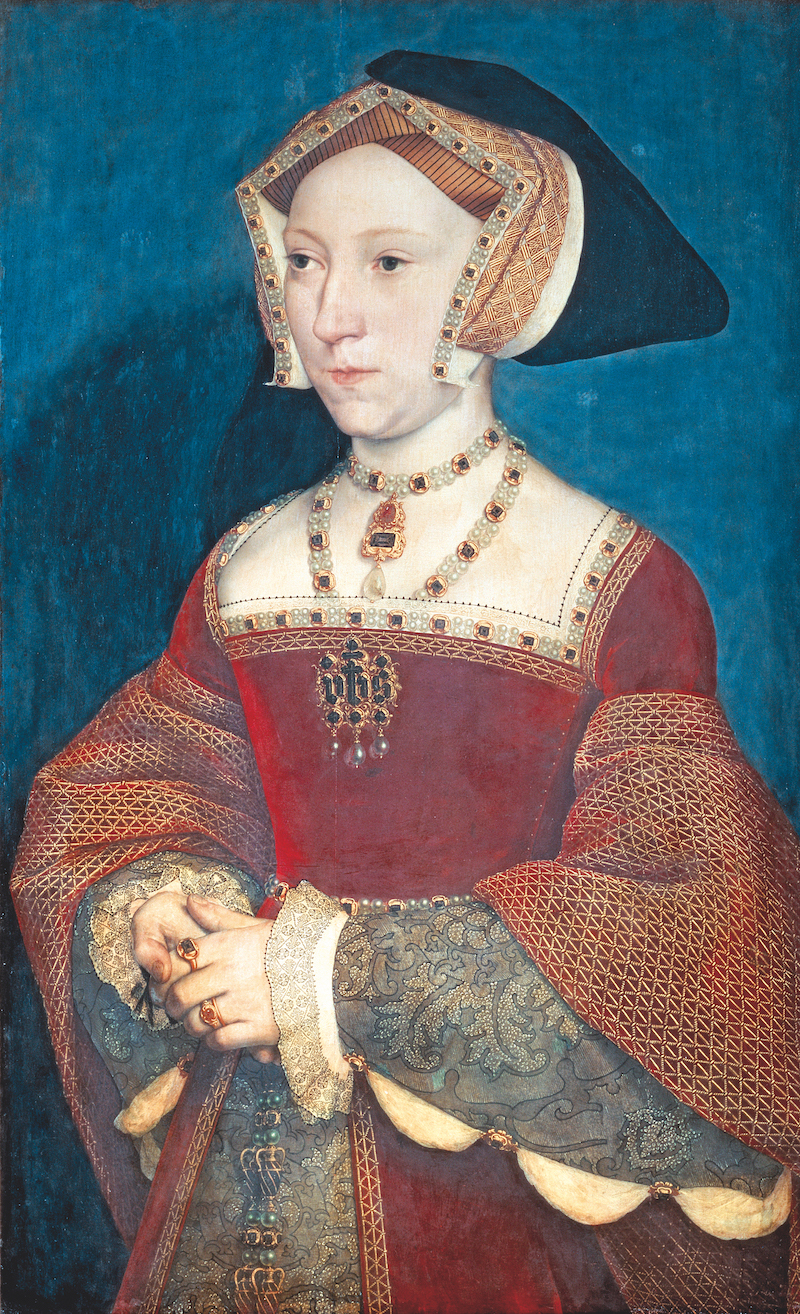When Henry VIII’s third wife, Jane Seymour, died after giving birth to the long-wished-for prince in 1537, Thomas Cromwell immediately began enquiries into the marriageable ladies of the French royal family. The rapidity of this search reflected the reality of the situation: the realm needed a queen and brokering a dynastic marriage was a protracted business. Henry’s previous wives had not been strangers to him. Katherine of Aragon, although a foreign princess, was his older brother Arthur’s young widow; Anne Boleyn had been Katherine’s maid of honour; Jane Seymour had served both her predecessors in this role. But now Cromwell set out to find a potential partner among the princesses of Europe.
Portraiture played an important role in international marriage negotiations. Early in 1538 Henry expressed himself ‘desirous of’ a ‘marriage with the Duchess of Milan’, by which he meant Christina, the 16-year-old widowed daughter of King Christian II of Denmark. Her portrait was painted by Hans Holbein the Younger and brought to England, where the sight of it, Eustace Chapuys wrote to Mary of Hungary, ‘put [Henry] in much better humour’. Christina’s relatives, however, were less enthused at the prospect of a match; though we do not know if Christina ever really said ‘If I had two heads, one should be at the King of England’s disposal’, the news of Henry divorcing his first wife and beheading the second would not have increased his appeal as a potential marital partner.
Instead, Cromwell diverted Henry’s attention to another prospective bride: Anne of Cleves, the daughter of Maria of Jülich-Berg and John III, Duke of Cleves. Writing that she was said to ‘excell … the Duchess [of Milan] as the golden sun did the silver moon’, Cromwell presented Anne as a superior candidate, brushing over the fact that Christina was out of reach. Holbein was duly sent to the family house at Düren to paint a portrait of Henry’s proposed bride.
The king’s ‘sister’
It was also customary for diplomats or ambassadors to visit a foreign court to gather intelligence about the prospective bride’s demeanour, skills and pastimes. Like Holbein, the diplomat Nicholas Wotton also spent time at Düren, and reported back to England in a letter now preserved in the British Library. The letter was badly scorched in a fire, but we can still read the much-quoted passage which refers to Anne of Cleves growing up ‘never from [her mother’s] elbow’:
She hathe from her childhode (lyk as the Lady Sybille was, till she was marryd, and the Ladye Amelye has been and is) ben brought up with the Ladye Duchess her mother and yn manner never from her elbow … All the gentlemen of the court, and other that I have askyd of, rapport her to be of verye lowlye and gentyll conditions.
Lady Sybille and Lady Amelia were Anne’s sisters, the latter also still unmarried, the former having made a politically advantageous marriage to the Electoral Prince John Frederick of Saxony. Anne of Cleves, we learn, ‘occupieth her tyme most with the nedyll’:
she canne reede and wryte her [the paper is burnt away in this passage] Frenche latyn or other langaige she […] nor yet she canne not synge nor pleye […] onye instrument for they take it heere yn Germanye for a rebuke and an occasion of lightnesse that gre[t] ladyes shuld be lernyd or have enye knowledge of musike.
In other words, it was considered inappropriate for a young woman of Anne’s status to sing, make music or be overly scholarly. Wotton reported that Anne was intelligent, and that she was not prone to indulging in drink, although he formulated this in a more delicate way: ‘I could never here that she is ynclyned to the good chere of this countrey.’
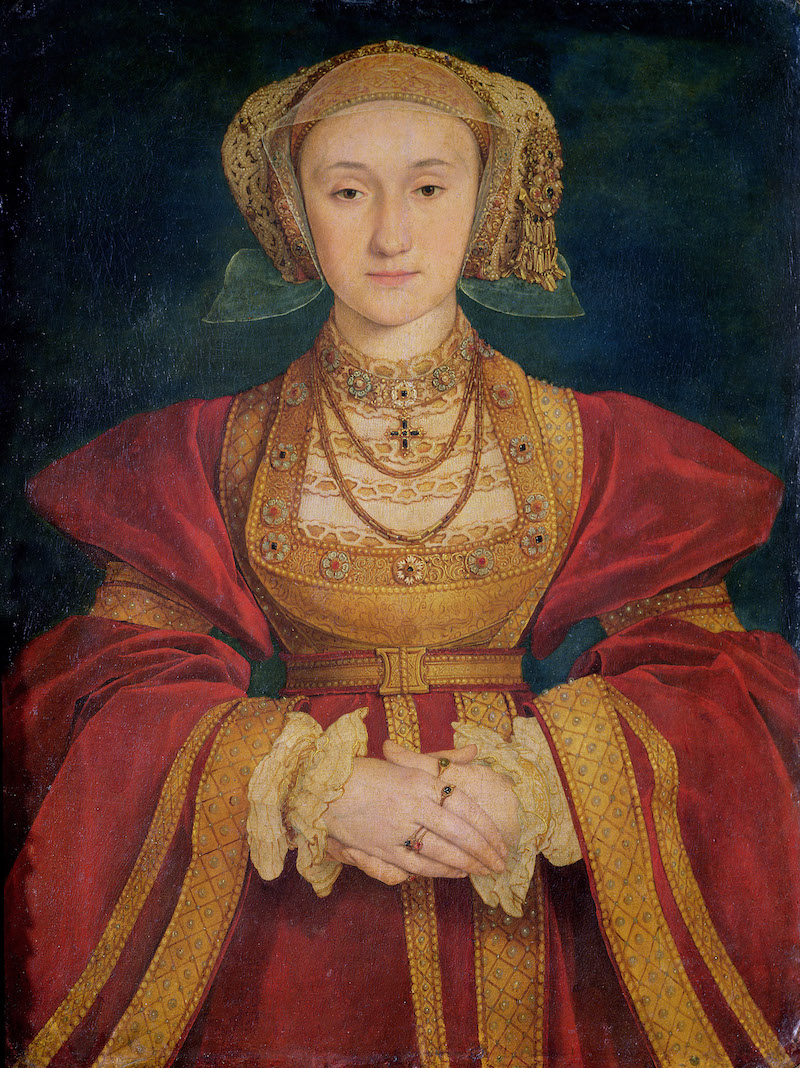
Despite such promise, the Tudor-Cleves marriage lasted only six months before being declared unconsummated and subsequently annulled ‘by reason of a precontract between lady Anne and the marquis of Lorraine’. Anne showed herself co-operative, and a ‘provision’ was made through which she was ‘considered as the King’s sister’ and given ‘precedence over all ladies in England, after the Queen and the King’s children’. She was also given a substantial annual income, the manors of Richmond and Blechingley, rich furnishings for these houses, plate, clothes, jewels, pearls and funds to pay servants. Henry would soon marry another former maid of honour, Catherine Howard, who would be beheaded for adultery. Anne of Cleves survived Henry, participating in the coronation of Queen Mary I in 1553 as one of the senior ladies of the court alongside Mary’s sister Elizabeth.
Anne of Cleves stands out from Henry’s other five wives in several ways: she was the only spouse Henry had not met before the marriage was brokered; hers was the shortest marriage, and she ended up benefiting most from it. The friendly way in which the king and his new ‘sister’ behaved towards each other was also remarkable. A touching example of intimacy can be found in Henry doctoring ‘A plaster for my ladye Anne of Cleve to mollifie, and resolve, conforte and cease payne of colde and wyndie causses’. These, however, are not the things for which Anne is most remembered.
Ugly words
Anne of Cleves became known to posterity as Henry’s ‘ugly wife’. This is in part because the 17th-century historian and bishop Gilbert Burnet introduced the term ‘Flanders Mare’ and attributed it to Henry, after which it became a commonplace, no doubt because it also fitted the narrative of his disenchantment with his fourth wife. But another reason that Anne’s association with ugliness stuck is that, upon her arrival in England, letters were exchanged in royal and diplomatic circles that were critical of her appearance and, in particular, her attire. Such expressions should, however, not be taken as innocent comments. These accounts were highly political and served a particular aim. They were also not necessarily based on the writer’s personal experience. Diplomats, ambassadors and courtiers often relied on other people’s statements for events they had not personally witnessed – the appearance of a bride’s apparel, for example. The ways in which foreign royal brides were shown to the inhabitants of their new country, such as in a procession, were very similar across Europe, and diplomats turned to stock phrases to describe foreign princesses. These accounts therefore reveal more about the genre of writing about foreign brides than about the women themselves.
Perhaps the most outspoken is a letter sent by the French ambassador to England, Charles de Marillac, to Anne de Montmorency. Echoing the judgement of those who had seen her up close, he says, ‘la reine d’Angeleterre’ is ‘not found as young as they thought’. ‘Nor’, he continues, ‘the great beauty that everyone affirmed’. On the same day de Marillac wrote to the French king Francis I: ‘As far as one can judge, she is about 30 years of age, tall and thin, of medium beauty, and of very assured and resolute countenance.’ He notes: ‘She was clothed in the fashion of the country from which she came’, and mocks the style of Anne’s ladies in waiting and gentlewomen, who ‘are more inferior in terms of beauty than their mistress, and they are dressed in a type of dress so heavy and badly becoming that they would almost be thought ugly even if they were beautiful’. Such descriptions are typical of diplomatic accounts. Anne of Cleves’ ladies, however, were particularly strange to de Marillac because they, as he explained to Francis I, ‘were clothed in the same sort of clothing, which to many looked like a strange thing’. They seem to have all been wearing the same outfit, as if it were a livery or uniform, which would have given them a more outlandish look as a group.
These outfits may have been considered heavy or inelegant when compared to the styles popular in England at that moment, but so were some of the garments worn by Henry’s earlier wives: the verdugado, or farthingales, popularised by Katherine of Aragon meant that a skirt could take up a lot of space, and Jane Seymour’s revival of the ‘old-fashioned’ gable hood resulted in women’s hair at the Tudor court – previously seductively visible if a French hood was worn – being hidden once more by boxy constructions, somewhat resembling the roof of a house, worn with a veil. Bulkiness of attire, then, seems not to have been the problem with Anne’s often-derided wardrobe choices. To understand the root cause of this antipathy, we should look to queenly and courtly clothing further afield.
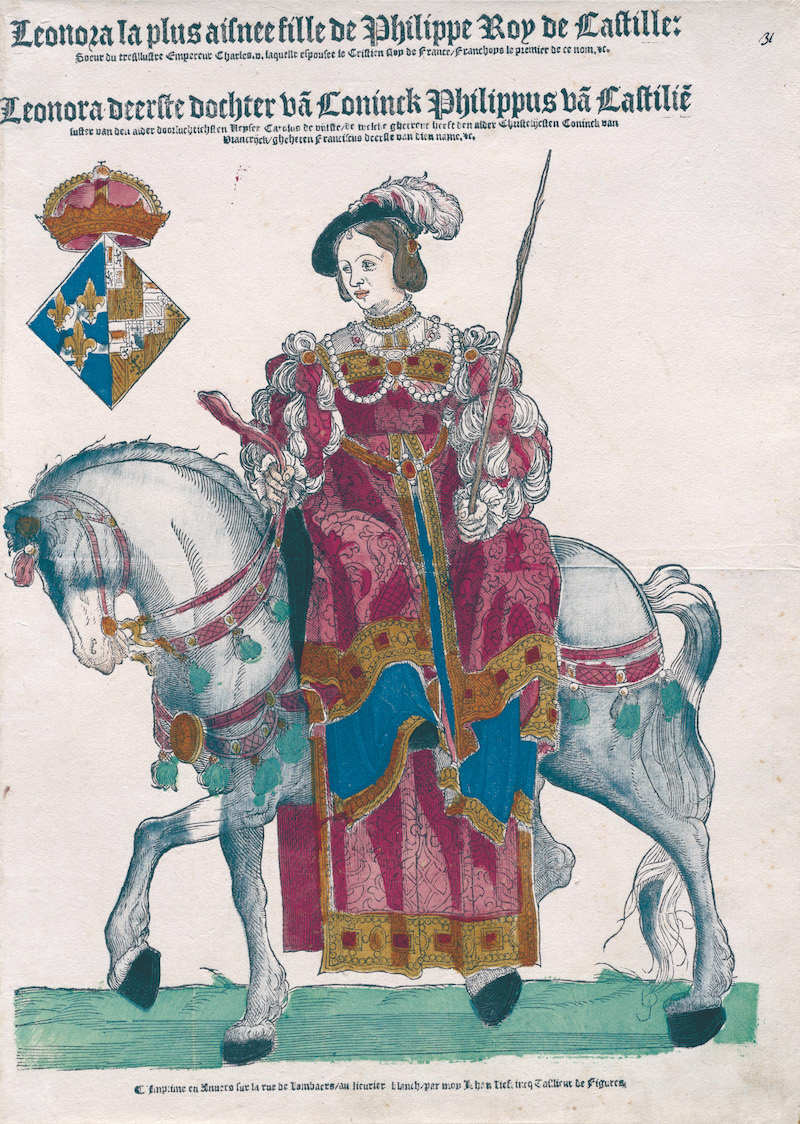
Uncomplimentary news of Anne’s appearance made its way to Eleanor of Austria, the second wife of Francis I, who shared this delicious bit of scandal with the Papal Legate, Alessandro Farnese, who was on a diplomatic mission to improve the relationship between France and the Holy Roman Empire. Farnese, not averse to gossip himself, wrote to his grandfather, Pope Paul III: ‘The queen of France tells me that … the new Queen is worthy and Catholic, old and ugly, so that when the King saw her he was not pleased with her in that German dress, and made her dress in the French fashion.’ Whatever news seems to have reached Farnese through the grapevine appears to get to the heart of why Anne had not been considered beautiful: she had been dressed in outlandish fashion.
References to Anne’s sense of style can be found in various sources. Honor Grenville, Viscountess Lisle, who was stationed in Calais, received a letter from an acquaintance in England that noted that Anne had worn ‘a rich attire upon her head of her own country fashion’. Edward Hall’s Chronicle, a history of the English royal houses from the reign of Henry IV to that of Henry VIII, offers further insight on the foreign fashions worn by England’s new queen: a ‘gowne of ryche cloth of gold set full of large flowers of great and Orient Pearle, made after the Duche fassion rownde’. Hall seems complimentary enough about the splendour of her clothes, but he does not appear to have been entirely enamoured with her choice of headdress:
On her head she had a cap as she ware on the saturdaie before with a cornet of laune, which cap was so ryche of Perle and Stone, that it was judged to bee of great valew.
This cap looks to have been lavish and precious, but it was not made in a style ‘en vogue’ at the English court. We know this because in a description of the joust, another event organised in honour of the royal wedding, Hall shows himself extremely enthusiastic about Anne’s change of headdress:
The Sonday after were kepte solempne Justes, which muche pleased the straungiers. On whiche daie she was appareiled after the Englishe fashion, with a Frenche whode, which so set furth her beautie and good vysage, that every creature rejoysed to behold her.
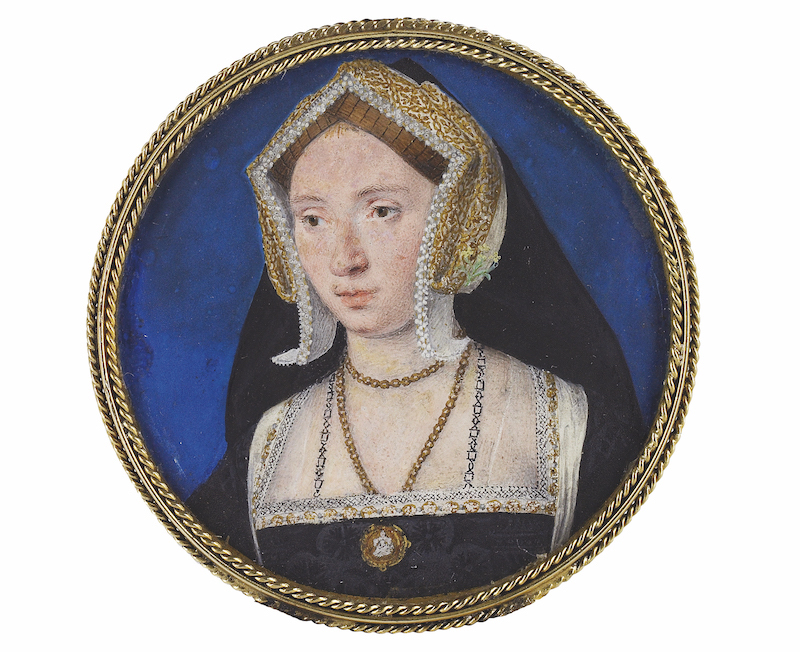
The ‘French hood’, considered ‘English fashion’ by Hall, was probably first seen at the Tudor court when worn by Henry’s sister Mary Tudor, briefly queen of France when she married Louis XII in 1514. It later became the preferred style of Anne Boleyn. Interestingly, an urban perspective on this fashion trend can be found in the Chronicle of the Grey Friars of London, which depicts Anne of Cleves as a trendsetter, whose adoption of the French hood encouraged other ladies in England to follow suit. It records that ‘thene beganne alle the gentylwomen of Yngland to were Frenche whooddes with bellementtes of golde’. (That is, French hoods with costly decorative borders of gold.) Whether the Grey Friars had an eye for fashion seems to be irrelevant here: one might similarly ask how a Papal Legate could judge a brief third-hand fashion description, or how an ambassador could comment on hearsay. What matters is that the record keeper at Grey Friars apparently saw women copy Anne of Cleves’ new French style, suggesting that her former Low Country apparel, previously derided, was quickly forgotten by the masses.
Formulaic fashion
When de Marillac wrote that Anne ‘was clothed in the fashion of the country from which she came’, this declaration resembles many similar statements found in the letters of his contemporaries about foreign princesses. When, in 1476, Beatrice of Naples married the king of Hungary, one chronicler noted – arguably stating the obvious – that she attended the crowning before the marriagein clothes of the type worn in Italy. During the wedding she was remarked to have worn a veil following the custom of women in Italy. A year earlier, Hedwig Jagiellon married George, Duke of Bavaria-Landshut, and an eye-witness commented on the skirt worn by the bride: wide compared to locally worn skirts, and made in accordance with the customs of her native country. Another commentator writes that Hedwig had worn a Polish dress deemed costly. In other words, we do not learn very much from these accounts regarding the actual appearance of the clothing worn, only something that could have been guessed without attending the marriage.
The same is true of headgear, as Anne of Cleves found: fashions in headdress and hairstyles differed substantially across Europe, and commenting on local coiffures or headcovers seems fairly standard. When Eleanor of Austria married Francis I of France, an eye-witness marvelled that ‘her head was adorned and dressed in the Portuguese style’. Eleanor was clearly following the example of the Empress Isabella of Portugal, who wore braided puffs of hair over her ears. In doing so, Eleanor reminded those watching of her earlier marriage to King Manuel of Portugal – a sartorial statement whose meaning had not eluded the eye-witness. Another queen’s headdress was commented on in the festival book S’ensuit l’ordre qui a este tenue a lentree de la royne a Abeville (1514), which records that when Mary Tudor married Louis XII of France she wore a ‘billement on her head in the style of her country’. The Venetian historian Marino Sanuto wrote: ‘The Queen was very magnificently dressed, both her gown and head gear being of the English fashion, and very costly, both in jewels and goldsmiths.’
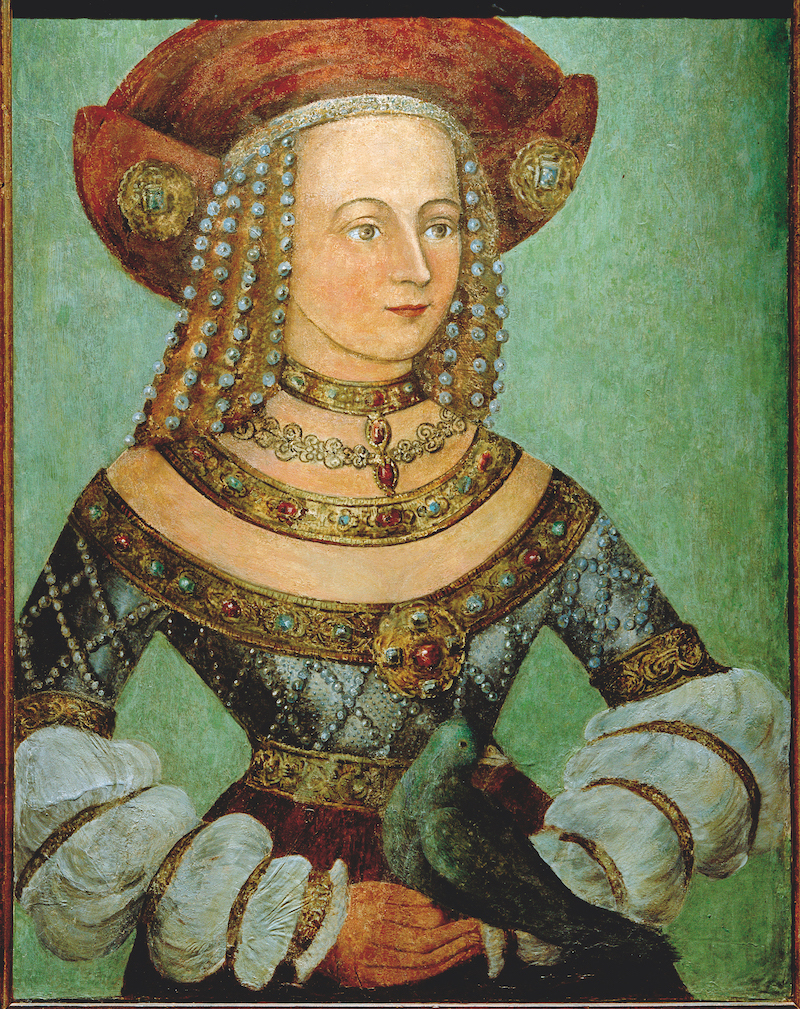
It appears that the outfits worn by foreign princesses were not always admired. Hall’s remark that Anne changing her headgear to a French hood offset her beauty is not unlike that of an anonymous writer recording Mary Tudor’s appearance in Abbeville: ‘A little before dinner the queen was outfitted in the fashion of France, which was better to see than the fashion of England.’ Hedwig Jagiellon attracted similar comments: the chronicler Hans Origen predicted that she would make a very suitable duchess – as soon as she started dressing in the German fashion.
Fit for a fool
There is, however, something about Anne’s ‘Dutch’ fashions that has been previously overlooked by dress historians. At the Tudor court European fashions seem to have been all the rage; wardrobes were filled with Spanish, ‘romayne’ (Burgundian) and French trends. Dutch attire, though, appears to have been comparatively rare. Katherine Parr’s tailor bill from 1543 included some, alongside Italian, French and Venetian gowns. Mary I, when she was queen, appears to have possessed one Dutch gown in 1557. Her accounts show that she acquired several further Dutch gowns, but that these were not for her own use: Mary used them to clothe her fool, Jane. Jane the fool appears to have been clothed at Mary’s expense as early as 1537, although the style of the clothing is not specified in the years before Mary ascended the throne. Another of Mary’s fools, referred to as ‘Beden’, was also provided with a Dutch gown. If that name is not an alias for Jane, this suggests that the Dutch gowns – unusually multicoloured and sporting stripes or a checked pattern – were used as a kind of liveried uniform for Mary’s fools; their distinctive styles would have stood out against the predominantly French gowns worn by the fashionable ladies of the court at this stage.
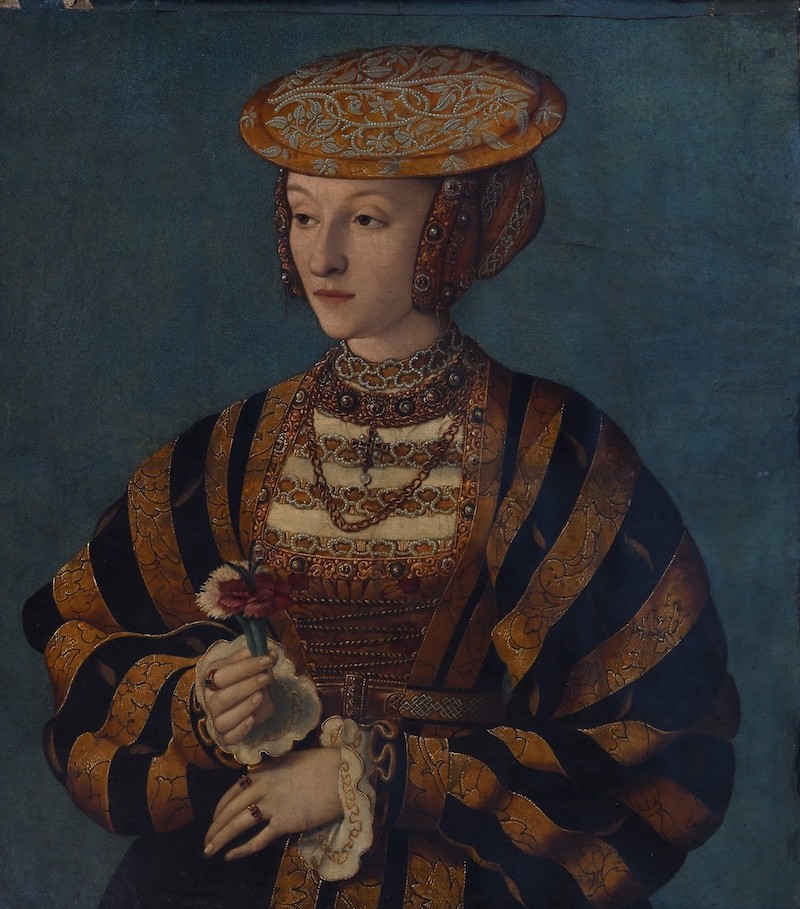
It is possible, then, that when Anne of Cleves arrived in England, Henry VIII had already been exposed to his daughter’s fool for several years, perhaps dressed in a livery in the ‘Dutch’ fashion. This does not mean that Henry would have interpreted Anne’s attire as a fool’s livery. But the fact that a style or cut of gown could eventually come to be used in this way suggests that this would have been a fashion unfashionable enough to be safely used for this purpose.
What’s in a name
Alessandro Farnese referred to Anne as ‘ugly’ and de Marillac wrote that she was not ‘the great beauty that everyone affirmed’. It is important to remember that de Marillac based his account ‘on the judgement of those who have seen her from nearby’, so not on hisown observations. And Farnese’s account is at best third- or fourth-hand. Their comments were political in nature, and indicate that by the time their letters were sent Henry’s discontent with his new wife was already brewing.
Suggesting the king could not perform the consummation was a dangerous thing, so the language used during this process describes Henry’s conscience rendering him unwilling to make love with a woman who, in his eyes, was precontracted and not free to marry. The wording used to describe Anne, such as by John Chamber, court doctor, is less than complimentary: ‘His grace found her [Anne’s] body in such a sort disordered & indisposed to excite & provoke any lust in hym … that his majesty could not in any wise overcome that lothsomeness, ne in her company be provoked or stered to that act.’
When historians such as Gilbert Burnet, and, after him, Tobias Smollett in A Complete History of England (1748), described Anne as a ‘Flanders Mare’, they took at face value the formulaic language used to describe the attire of princess brides and letters by ambassadors expressing a political view of Henry’s disenchantment with his new wife in the first days of their acquaintance, as they did the language used in the legal process to undo the marriage. None of these sources say anything about Anne’s actual looks. As was the case for the Tudor court in the late 1530s, portraits by Holbein and others remain the best indication of what she looked like. In those portraits we see a woman who would survive Henry and live to see the coronation of Mary I.
Nadia van Pelt is the author of Intercultural Explorations and the Court of Henry VIII (Oxford University Press, 2024).

